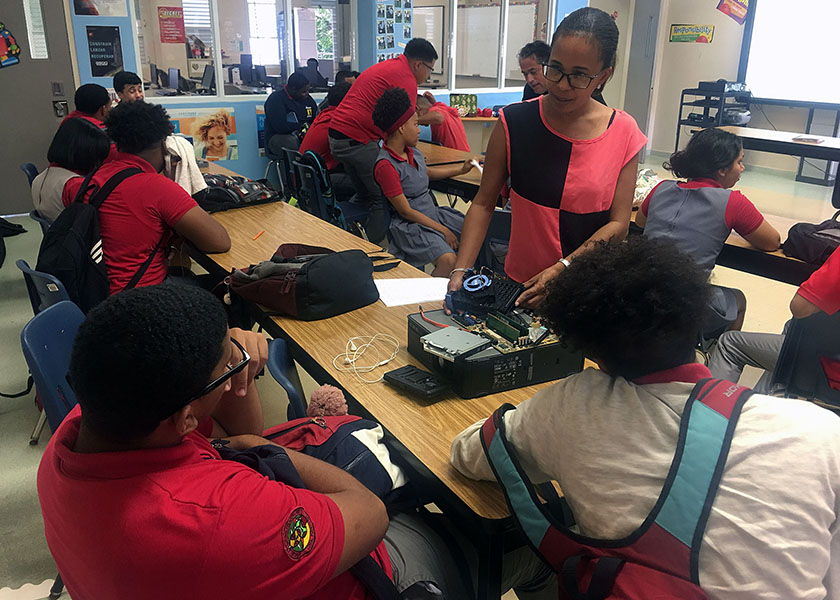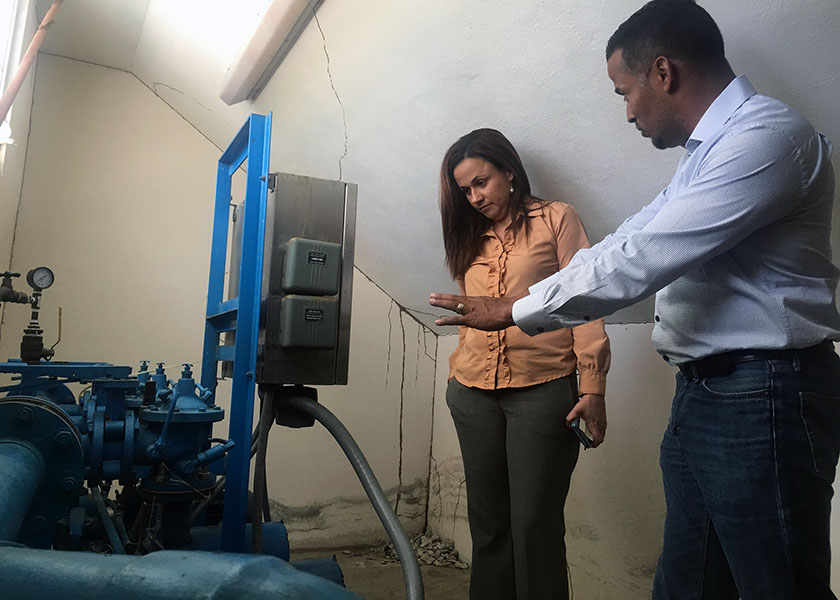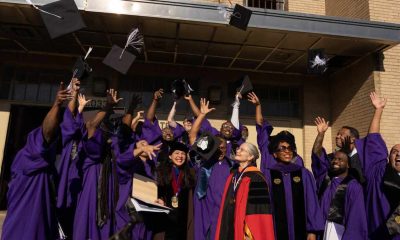Featured
After Hurricane Maria, Superior Vocational High School in Loíza Makes Slow Progress
After Hurricane Maria, recovery efforts have been slow at Superior Vocational High School in Loíza, Puerto Rico. NNPA Newswire Special Correspondent Tatyana Hopkins reports on Hurricane Maria’s impact on education across the island.

By Tatyana Hopkins (NNPA Newswire Special Correspondent)
LOÍZA, Puerto Rico—Thousands of students in Puerto Rico have settled back into classrooms after Hurricane Maria ripped through the island in September, knocking out electricity to the island and closing all of its 1,100 schools.
But, reopening the schools once used as shelters and community centers in the storm’s aftermath has proven to be a small step towards normalcy, as the island inches towards recovery. Though schools are open, little progress has been made in their recovery, and many schools are left still improvising to cope with lack of electricity and water.
The cash-strapped U.S. territory was already hurting financially, even before the hurricane caused about $100 billion in damage to the island, according to Puerto Rico’s government. So far, federal lawmakers have appropriated just a fraction of the local government’s $94 billion request, appropriating just $23 billion in direct aid to the island, and only a portion of it has been released.
Meanwhile, the Federal Emergency Management Agency (FEMA) has spent $6 billion in recovery efforts in Puerto Rico. Power has been restored to more than 90 percent of the island, but thousands remain without electricity, while other residents with electricity experience random blackouts for hours at a time.
Recovery for schools has been particularly slow, in part, because of the country’s staggering debt. The island is $70 billion in debt, which last year caused the closing of 184 schools before the storm. The island spends less per student than any state or U.S. protectorate.

[/media-credit] Nilka Modesto teaches computer science to students in a classroom at Superior Vocational High School in Loíza, Puerto Rico. Use of the computer lab next door to their classroom is limited due to frequent blackouts after Hurricane Maria. (Tatyana Hopkins/NNPA)
The Superior Vocational High School in the small coastal town of Loíza is an example of the ongoing struggles of public education across the island.
After Hurricane Maria hit the island in September, the school reopened its doors last November, but promptly closed again.
“In November, we had classes just one week with a generator, then closed again until January because the generators kept shutting off,” said the school’s principal, Doris Villaran.
Gas-powered generators are being used across the island to supply electricity.
Superior Vocational suffered little structural damage, she said. It has been opened for a full three months now. Still, some things are not as they were before the storm. The school now operates on a shortened schedule, without running water or air-conditioning. Students use the school’s Microsoft Showcase computer equipment sparingly for fear that the island’s regular blackouts could ruin them.
Still, Superior Vocational is running better than others in the Humacao school district, which includes schools on the island’s east coast.
“The hurricane came directly through this region,” said Sol Ortiz Bruno, the Humacao school district’s regional director of education.
Loíza, where Bruno was spending the day, sits in a tsunami zone and gets hit by seasonally high waves from the ocean. The waves can flood the area, because of its low elevation. Two weeks earlier, the city was hit by heavy waves that caused flooding and closed the school for a few days, Bruno said, as she met with maintenance workers about damage to the building.
“And today we are preparing for tsunami season,” she said.

[/media-credit] Humacoa School District Director Sol Ortiz Bruno (left) and the area’s Public Building Authority Director Emmanuel Hurtas examine the water system Superior Vocational High School, in Loíza, Puerto Rico. (Tatyana Hopkins/NNPA)
Bruno said that neighboring towns in the island’s central mountain ranges, like the municipalities of Humacao and Caguas, were hit worse. The Humacao school district consists of 17 towns. At least 4,600 students of its 43,000 students either moved to the United States or other areas of Puerto Rico after the hurricane. Two of Superior Vocational’s teachers also left after the hurricane. Including the other 10 schools in Loíza, at least 1,200 of the town’s students moved away.
“We lost the most students of any other region,” she said.
Of the school district’s 159 schools, 88 are fully operational with electricity from the city’s power supply. Fifty-three schools do not have electricity; 14 run on electricity from generators provided by the federal government, two are closed temporarily, because of structural damage and two are permanently closed.
“The school is open, everyone is here and doing what they’re supposed to do, but it is hard being here when nothing is working,” Superior Vocational Principal Villaran said.
Superior Vocational offers six trades, nursing, business administration, computer information, culinary arts, marketing and barbering. Teachers have had to adjust their curriculum, because of limited facilities.
One of the big problems is a lack of air-conditioning in an area where temperatures top 90 degrees, usually by noon. Hurricane Maria ruined the school’s rooftop air-conditioning system, forcing the school to alter its hours to compensate for the heat. Students normally attended school from 8 a.m. to 3 p.m., when the school had air conditioning. Now, they go from 7:30 a.m. to 12:30 p.m., because the temperature is too high.
“When the computers are off, you can feel the heat,” said computer science teacher Nilka Modesto. “So, imagine how it would feel with them on.”
Modesto said that, because the power outages have limited use of the school’s computers, her instruction has moved from hands-on practice learning to theory.
“I can’t teach the normal way, because of the heat and lack of Internet,” Modesto said.
Lack of Internet access has also left the school’s phones out of service, forcing staffers to use their personal cell phones.
Blackouts have also damaged the school’s electric-powered water system meaning students in barbering classes cannot use in-classroom sinks to wash hair. Instead, they go downstairs to use the bathroom’s makeshift sink.
To compensate for the failed water systems, school administrators have connected three 100-foot water hoses to a main water line to fill bins in the buildings restrooms, so students can wash their hands and to flush the toilets.
“Then we take the same hose and run it to the kitchen, where we use it to wash the dishes,” Villaran said. “We use bottled water for cooking.”
The only other option would be to share a more functional building with another school where one group would go to school for five hours in the morning, and the other group attend classes for five hours in the afternoon, Villaran.
“That’s more complicated than filling the cans with water, and that’s why we stay here,” Villaran said. “We are just waiting for someone to come fix this.”
But, that could take a while.
“The schools don’t get dedicated funding, and after Maria we have to go through the local and federal government,” Bruno said. “We don’t have the money and we have to wait for it to be approved. They make us wait and the process is really slow.”
Emmanuel Hurtas is the director of the Puerto Rico Public Buildings Authority (PBA) for the Humacao school district.
He is responsible for 50 schools in the Humacao school district.
Hurtas said that he must weave his way through a three-part bureaucracy to get needed repairs done.
The first agency approves the project, the next buys the equipment and the last evaluates the purchases before giving the final approval to begin work.
He said the process could take up to the three weeks for a simply request.
Puerto Rico’s legislators have introduced school reforms that they say will revamp the underperforming school system and cut costs. It includes closing schools with less than 150 students; there are 300 of them on the island. They also have proposed introducing charter schools to the island. Teachers and PBA employees opposed the plan.
Puerto Rico’s Board of Education has announced it plans to repair schools damaged by Hurricane Maria, Bruno said, but, so far, it hasn’t issued a date for its implementation, largely, because it has no money.
Consequently, Bruno said, “They make us wait. The process is really slow.”
Through it all, students in Loíza remain optimistic.
“Things are different at the school, but I don’t see a difference in the way I am being taught,” said Doralys Delvalle, 17, a senior nursing student at Superior Vocational whose family lost the roof of their home to the hurricane. “I’m excited to graduate soon.”













































